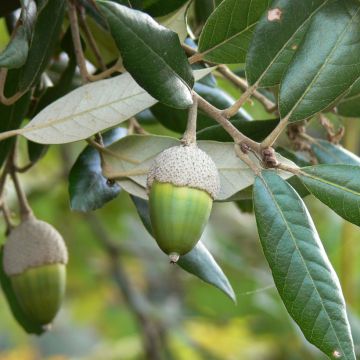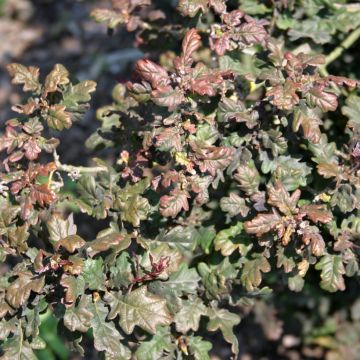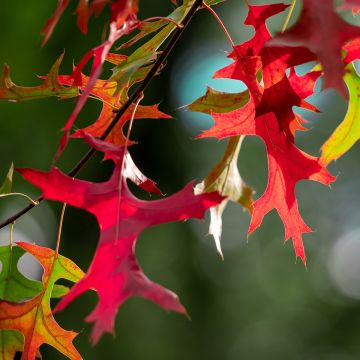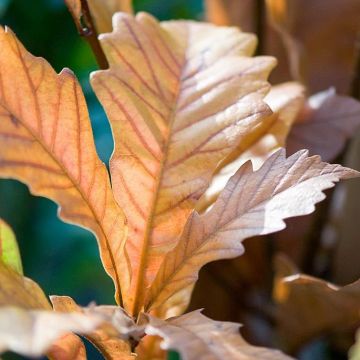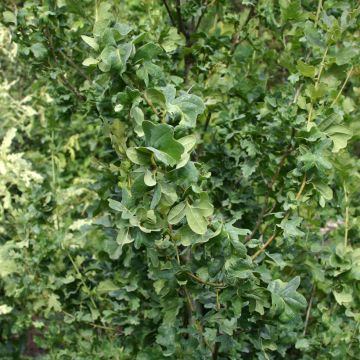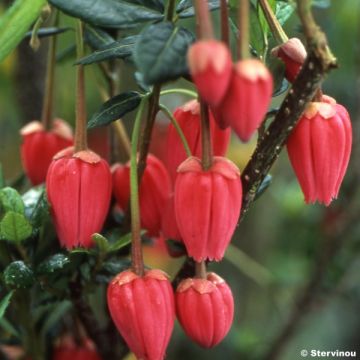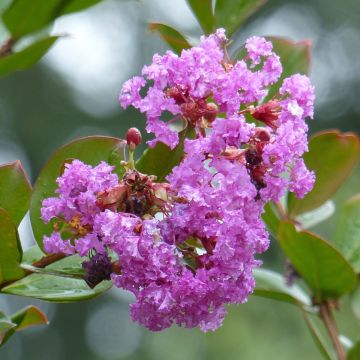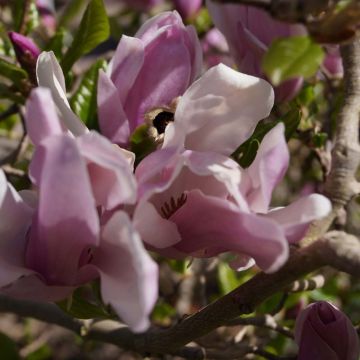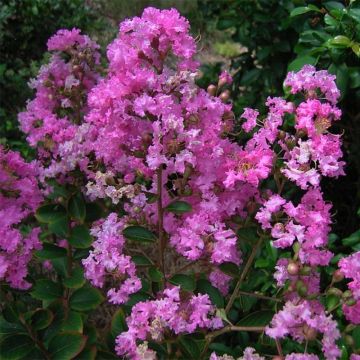

Quercus pontica - Pontic Oak


Quercus pontica - Pontic Oak
Quercus pontica - Pontic Oak
Quercus pontica
Pontic Oak
Why not try an alternative variety in stock?
View all →This plant carries a 24 months recovery warranty
More information
We guarantee the quality of our plants for a full growing cycle, and will replace at our expense any plant that fails to recover under normal climatic and planting conditions.
From €5.90 for pickup delivery and €6.90 for home delivery
Express home delivery from €8.90.
Does this plant fit my garden?
Set up your Plantfit profile →
Description
Quercus pontica, the Armenian oak or Pontine oak, is a botanical species of small development that grows in the forests of the mountains of western Caucasus and northeastern Turkey. It forms a large bush or a small stout tree with a wide crown and has deciduous characteristic foliage, composed of very large tough leaves finely toothed resembling those of the chestnut tree. It is a slow-growing species well adapted to heat, wind, and soils with a tendency towards limestone. The last advantage of this unusual oak is its almost marcescent foliage, which, even when dry, remains attached to the branches for a long time.
The Armenian oak, also known as pleated oak, Pontine oak, or Pontic oak, belongs to the family of Fagaceae. In nature, it is found between 1,300 and 2,100 metres above sea level, in the mountain forests of the northern Near East, Armenia, and the Caucasus. It takes the form of a large bush or a taller tree, reaching up to 12 metres in height in rich soil. It is a species of warm temperate climate, which appreciates limestone soils, but fears prolonged drought.
The Armenian oak, which grows slowly (approximately 10 cm per year), reaches an average size of 5 metres in all directions in our gardens. It naturally forms several trunks but can be trained to have a single trunk. Its bark is grey and has long wrinkles. Its compact crown changes from a widely conical shape to a more rounded shape as it ages. Its branches are remarkably thick and erect. They are glabrous and often angular, with very large angular terminal buds of brown-yellow colour. The leaves, arranged alternately on the branches, are broadly elliptical to obovate in shape and remarkably large: they measure 15 to 25 cm in length and up to 10 cm in width. Their edges are lined with fine teeth. They have a "waxy" texture, with a shiny medium green colour on the upper side and grey-green on the underside. In autumn, they turn yellow to brownish-yellow and generally remain on the tree for a long time. The flowers appear in pendulous catkins, greenish-yellow, from May to June. The fruits are ovoid acorns about 2 cm long, half buried in the cupule. The Armenian oak has deep taproots and prefers a sunny and slightly sheltered exposure. It thrives in a dry to moist, well-drained, fertile, and slightly acidic to alkaline soil. While resistant to cold, it fears late frosts when young.
The Pontine oak is a tolerant species that acclimatises in regions that are not too harsh, as long as it is planted in a sufficiently loose and deep soil. It can be planted as a standalone tree, in a small grove, or as part of a large hedge, alongside the Montpellier maple, the holm oak Quercus ilex, the Portuguese laurel Prunus lusitanica, or the large Chinese Photinia Photinia serratifolia.
Report an error about the product description
Plant habit
Flowering
Foliage
Botanical data
Quercus
pontica
Fagaceae
Pontic Oak
Caucasus
Other Oak
Planting and care
Quercus pontica can be planted in autumn or spring. It prefers deep, fertile, slightly acidic, neutral, or alkaline soils, ranging from moist to dry. It dislikes shallow or excessively acidic rocky soils. It thrives in sunny and open exposures. It can tolerate pollution and heat. Protect it from excessively dry summers in the years following planting. Once established, this tree requires very little maintenance. It is not prone to diseases and parasites.
Planting period
Intended location
Care
This item has not been reviewed yet - be the first to leave a review about it.
Trees for small gardens
Haven't found what you were looking for?
Hardiness is the lowest winter temperature a plant can endure without suffering serious damage or even dying. However, hardiness is affected by location (a sheltered area, such as a patio), protection (winter cover) and soil type (hardiness is improved by well-drained soil).

Photo Sharing Terms & Conditions
In order to encourage gardeners to interact and share their experiences, Promesse de fleurs offers various media enabling content to be uploaded onto its Site - in particular via the ‘Photo sharing’ module.
The User agrees to refrain from:
- Posting any content that is illegal, prejudicial, insulting, racist, inciteful to hatred, revisionist, contrary to public decency, that infringes on privacy or on the privacy rights of third parties, in particular the publicity rights of persons and goods, intellectual property rights, or the right to privacy.
- Submitting content on behalf of a third party;
- Impersonate the identity of a third party and/or publish any personal information about a third party;
In general, the User undertakes to refrain from any unethical behaviour.
All Content (in particular text, comments, files, images, photos, videos, creative works, etc.), which may be subject to property or intellectual property rights, image or other private rights, shall remain the property of the User, subject to the limited rights granted by the terms of the licence granted by Promesse de fleurs as stated below. Users are at liberty to publish or not to publish such Content on the Site, notably via the ‘Photo Sharing’ facility, and accept that this Content shall be made public and freely accessible, notably on the Internet.
Users further acknowledge, undertake to have ,and guarantee that they hold all necessary rights and permissions to publish such material on the Site, in particular with regard to the legislation in force pertaining to any privacy, property, intellectual property, image, or contractual rights, or rights of any other nature. By publishing such Content on the Site, Users acknowledge accepting full liability as publishers of the Content within the meaning of the law, and grant Promesse de fleurs, free of charge, an inclusive, worldwide licence for the said Content for the entire duration of its publication, including all reproduction, representation, up/downloading, displaying, performing, transmission, and storage rights.
Users also grant permission for their name to be linked to the Content and accept that this link may not always be made available.
By engaging in posting material, Users consent to their Content becoming automatically accessible on the Internet, in particular on other sites and/or blogs and/or web pages of the Promesse de fleurs site, including in particular social pages and the Promesse de fleurs catalogue.
Users may secure the removal of entrusted content free of charge by issuing a simple request via our contact form.
The flowering period indicated on our website applies to countries and regions located in USDA zone 8 (France, the United Kingdom, Ireland, the Netherlands, etc.)
It will vary according to where you live:
- In zones 9 to 10 (Italy, Spain, Greece, etc.), flowering will occur about 2 to 4 weeks earlier.
- In zones 6 to 7 (Germany, Poland, Slovenia, and lower mountainous regions), flowering will be delayed by 2 to 3 weeks.
- In zone 5 (Central Europe, Scandinavia), blooming will be delayed by 3 to 5 weeks.
In temperate climates, pruning of spring-flowering shrubs (forsythia, spireas, etc.) should be done just after flowering.
Pruning of summer-flowering shrubs (Indian Lilac, Perovskia, etc.) can be done in winter or spring.
In cold regions as well as with frost-sensitive plants, avoid pruning too early when severe frosts may still occur.
The planting period indicated on our website applies to countries and regions located in USDA zone 8 (France, United Kingdom, Ireland, Netherlands).
It will vary according to where you live:
- In Mediterranean zones (Marseille, Madrid, Milan, etc.), autumn and winter are the best planting periods.
- In continental zones (Strasbourg, Munich, Vienna, etc.), delay planting by 2 to 3 weeks in spring and bring it forward by 2 to 4 weeks in autumn.
- In mountainous regions (the Alps, Pyrenees, Carpathians, etc.), it is best to plant in late spring (May-June) or late summer (August-September).
The harvesting period indicated on our website applies to countries and regions in USDA zone 8 (France, England, Ireland, the Netherlands).
In colder areas (Scandinavia, Poland, Austria...) fruit and vegetable harvests are likely to be delayed by 3-4 weeks.
In warmer areas (Italy, Spain, Greece, etc.), harvesting will probably take place earlier, depending on weather conditions.
The sowing periods indicated on our website apply to countries and regions within USDA Zone 8 (France, UK, Ireland, Netherlands).
In colder areas (Scandinavia, Poland, Austria...), delay any outdoor sowing by 3-4 weeks, or sow under glass.
In warmer climes (Italy, Spain, Greece, etc.), bring outdoor sowing forward by a few weeks.

































